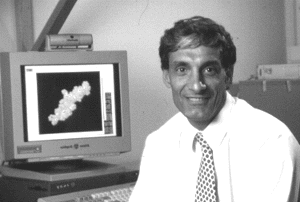|
|
New Science Program to Break BarriersBy Phil SneidermanHomewood |

Chemists, biologists, computer scientists and engineers usually work independently, pursuing their own research projects with their own tools and methods. But a $2.5 million grant will allow the university to train some of tomorrow's scientists and engineers in a new way, by breaking through some of the boundaries that traditionally divide these scientific disciplines.
The grant, to be provided over five years by the Burroughs Wellcome Fund, will help establish the Johns Hopkins Program in Computational Biology. The program will have a special emphasis on cutting-edge genomics research, in which scientists sequence DNA from cells and viruses and then use that information to solve the far more difficult questions of how cells assemble the larger molecules and complex structures that make them work.
It will be directed by Michael E. Paulaitis, professor and chairman of the Whiting School's Department of Chemical Engineering at Homewood, and George D. Rose, professor of biophysics and biophysical chemistry at the School of Medicine in East Baltimore. Graduate students and postdoctoral fellows from both campuses will be eligible to apply for the program.
 |
|
Michael E. Paulaitis, School of Engineering Photo by Robert Smith |
The goal, organizers say, is not to attract new students into biological research but to give students from other scientific fields and the engineering disciplines the training and tools to tackle tough biological problems. For example, computer scientists involved in gene research must learn to think of DNA sequences as more than just a series of ones and zeros in a machine; they need to understand the biological and chemical processes.
"We want to foster a program that utilizes the formally rigorous treatment that comes out of chemistry and physics but where the subject matter is biology," Rose says. "The trick is to produce scientists who can apply these formal techniques but who have the knowledge to preserve the richness and complexity of biological data."
 |
| George Rose, School of Medicine |
This change in the way scientists and engineers are trained is imperative, Paulaitis adds. "We just can't make significant advances or do the important research we strive to do without this multidisciplinary approach."
About 14 participants are expected to be enrolled in the new program at any one time; the first graduate students are expected to enter next fall. Their specialized training will include internships at the Institute for Genomic Research in Rockville, Md.
"I expect rhat the competition to participate in this program will be fierce," Paulaitis says. "Students recognize this as a new and exciting area of research, and there are many high-quality labs participating in the program, working on important research problems in this area. This will be a unique program, so we expect to attract and select the very best students from a spectrum of scientific and engineering disciplines."
Johns Hopkins is among six universities and educational consortia selected to receive these Burroughs Welcome grants since 1996, when the foundation launched a program called Interfaces Between the Physical/Chemical/Computational Sciences and the Biological Sciences.
"These awards are intended to improve the interdisciplinary training of promising graduate and postdoctoral students from the physical, chemical and computational sciences so they can better apply their unique knowledge and talents to biological problems," says Enriqueta C. Bond, president of the Burroughs Wellcome Fund. "We believe this is the only private program devoted to bridging the physical and biological sciences through institutional interdisciplinary training grants, and the awards help fill the gap left by federal funding efforts that are predominantly built around specific disciplines."
The Burroughs Wellcome Fund is an independent private foundation established to advance the medical sciences by supporting research and other scientific and educational activities. It was founded in 1955 as the corporate foundation of the pharmaceutical firm Burroughs Wellcome Co. In 1993, a gift from its sister foundation in the United Kingdom, the Wellcome Trust, enabled the fund to become fully independent from the company, which was acquired by Glaxo in 1995.
--Marjorie Centofanti of JHMI contributed to this article.
| GO TO JANUARY 19, 1999 TABLE OF CONTENTS. |
| GO TO THE GAZETTE HOMEPAGE. |